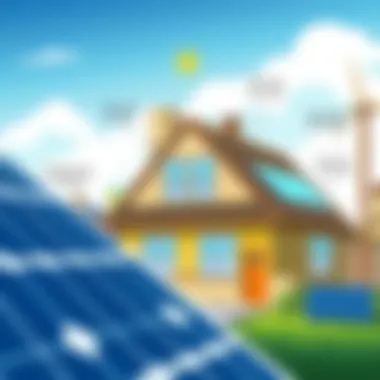Financial Impact of Residential Solar Energy Systems


Intro
As homeowners look for sustainable solutions to energy costs, solar power has emerged as a significant option. It's not just about going green; it's about making a sound financial decision. Choosing to install a solar system often raises questions concerning overall expenses, potential savings, and long-term returns. Understanding the financial implications of installing a home solar system is crucial. This guide sheds light on those elements, equipping homeowners with the knowledge needed to make informed decisions.
Investment Dictionaries
Key Financial Terms
When diving into the world of solar investments, it's essential to familiarize oneself with some financial terminology.
- Payback Period: This is the time it takes for the initial investment to be recovered through energy savings.
- Net Metering: This is a billing mechanism that allows solar energy system owners to receive credit for the excess energy their systems produce.
- Incentives and Rebates: Various federal, state, and local incentives can help lower installation costs.
- Return on Investment (ROI): A metric used to evaluate the efficiency of an investment, expressed as a percentage that reflects the gain or loss against the investment cost.
Each of these terms plays a pivotal role in assessing the viability and financial framework of home solar systems.
Investment Strategies Explained
Investing in solar energy isn't a one-size-fits-all equation. There are strategic paths one might consider. Some homeowners may choose a cash purchase, paying upfront for the entire system. Others might prefer financing options, like solar loans, which allow them to pay in increments over time. Another strategy is leasing, which lets homeowners use solar energy without the upfront costs of installation. Each of these methods comes with its pros and cons, depending on individual financial situations and goals.
"Choosing the right financing strategy can turn an initial expense into a cash-positive investment over time."
Financial Product Comparisons
Performance Metrics Analysis
To fully grasp the value of a home solar system, one must analyze its performance metrics.
- Energy Output: Measured in kilowatt-hours (kWh), this reflects the amount of energy produced by the solar panels.
- System Efficiency: This is the ratio of energy output compared to the sunlight received. Higher efficiency often correlates with higher costs.
- Durability and Warranty Length: Long-lasting products may offer better value in the long run.
By understanding these metrics, potential buyers can compare different solar products to find the best fit.
Cost-Benefit Evaluations
Evaluating the costs versus the benefits involves more than just installation prices. Consider these key points:
- Installation Costs: From mounting equipment to labor, installations can vary widely in price based on location and system complexity.
- Maintenance Expenses: While solar systems generally require minimal upkeep, occasional cleaning and inspections can incur costs.
- Long-Term Savings: Analyzing energy bills over the years can provide a clearer picture of potential savings.
Homeowners should weigh these financial aspects to determine if the investment aligns with their budget and energy needs.
For more detailed insights on solar energy financing options, refer to resources such as Energy.gov or DSIRE, which list incentives and financial measures available across the United States.
Understanding the financial implications of home solar systems is imperative for making astute investments. With careful consideration, potential solar users can navigate the financial landscape effectively.
Prologue to Home Solar Systems
The growing concern about climate change and skyrocketing electricity costs has led many homeowners to consider the installation of solar panels. This transition towards renewable energy not only presents an opportunity for individuals to reduce their carbon footprint but also offers tangible financial benefits. By investing in solar technology, homeowners can alleviate some of the pressures associated with rising energy prices. The introduction of home solar systems has transformed the way individuals consume energy, making it a pivotal topic of discussion in today's economic landscape.
Understanding Solar Energy
Solar energy, the energy harnessed from the sun's rays, is becoming increasingly accessible and efficient thanks to advancements in technology. At its core, solar energy is captured through photovoltaic cells that convert sunlight into electrical energy. These systems can power homes, reduce dependence on fossil fuels, and significantly lower electricity bills. The ability to generate one’s own electricity leads to a new era of energy independence, wherein homeowners take control of their power consumption rather than relying solely on conventional utility providers. The advancement in solar panel technology now allows for more efficient energy capture, meaning that even in less sunny climates, homeowners can benefit. This shift towards solar energy is not just about environmental sustainability; it directly influences financial savings and long-term investment returns.
The Rise of Home Solar Adoption
The surge in home solar adoption can be attributed to a mix of factors, from governmental policies to technological advancements. Programs promoting renewable energy have initiated numerous incentives that encourage homeowners to make the switch to solar. Many states now offer tax rebates, grants, or even lower utility rates for those who install solar systems.
- Awareness of Environmental Impact: Homeowners are increasingly aware of their carbon footprints and are seeking greener alternatives.
- Cost-Effectiveness: As the initial costs of solar installations decrease, the barrier to entry becomes manageable for the average homeowner.
- Energy Resilience: Solar systems can provide energy security, making homes less vulnerable to grid outages or price fluctuations.
This trend signifies a pivotal moment in energy consumption, where a combination of ecological and economic motivations drive homeowners to invest in solar technology. Understanding the financial implications of such investments will be crucial as we delve deeper into the overall costs and benefits associated with home solar systems.
Cost Breakdown of Home Solar Systems
Understanding the financial implications of home solar systems is crucial, especially when one considers the different components involved in a typical installation. A detailed cost breakdown illuminates how each aspect contributes to the total investment. Not only does this analysis help in budgeting, but it also uncovers potential savings and impacts on return on investment. By delving deeply into the initial investment, installation expenses, permitting fees, and ongoing costs, potential buyers can assess their financial commitments clearly and make well-informed decisions.
Initial Investment
The initial investment in a solar energy system is often viewed as daunting. The numbers can make one’s head spin. Typically, the cost is heavily influenced by the size and capacity of the solar system. A larger system can provide more energy, but it comes with higher upfront costs.
Many homeowners might find themselves pondering, "What will this really set me back?" On average, the price can range quite a bit depending on location and technology — from around $15,000 to $30,000 before any tax credits or incentives come into play. Financing options like loans or leases can mitigate these initial costs. It’s important to factor in potential tax credits and rebates too, as they could save thousands.
Installation Expenses


Installation expenses represent a significant chunk of the costs. This involves labor fees, equipment costs, and additional materials. Labor rates can vary widely, reflecting the local economy and experience of the installers.
In many cases, it’s prudent to engage a qualified contractor rather than trying to DIY — this isn't the place to cut corners. Most installation costs can form about 10% to 20% of your total investment. Moreover, depending on the roof's condition, additional upgrades might be required, adding to the overall bill. To sum it up, while installation can be a hefty price, skipping on quality can lead to higher long-term costs.
Permitting and Inspection Fees
Navigating through local permits can feel like picking your way through a minefield. Permitting and inspection fees are often overlooked in the budget. Different regions have different requirements, meaning some homeowners might not face these charges at all, while others could pay a few hundred dollars or more. It's essential to get these costs clarified upfront, as mishaps in this area could lead to delays and increased expenses.
Local government websites are a great place to start. They often list the fees associated with solar installations. Homeowners may also want to consult local solar contractors for insights on common fees they might encounter.
Ongoing Maintenance Costs
Once the solar panels are up and running, the expenses doesn't stop there. Ongoing maintenance is vital to ensure consistent performance. Regular checks and cleaning to maximize efficiency, alongside possible repairs, constitute the maintenance costs. While solar energy systems are robust, they still require some human interaction.
Typically, ongoing maintenance can range from a few hundred to over a thousand dollars a year depending on the system and local conditions. Homeowners must keep an eagle eye for performance drop-offs, especially after severe weather or heavy debris.
"Regular maintenance not only keeps the system operating efficiently but also ensures your investment continues to yield positive returns."
In closing, understanding the cost breakdown is indispensable for anyone considering solar systems. It highlights where the money goes and helps anticipate future expenses, making it easier to grasp the overall financial implications of such an investment.
Factors Influencing Solar System Costs
Understanding the various costs associated with solar systems is crucial for anyone considering this technology. Home solar systems are not just a set of panels installed on the roof; they come with a host of factors that can significantly affect pricing and overall financial implications. Grasping these factors can help potential buyers make informed decisions, aligning their budgets with their expectations and goals. Here, we will look at several elements that influence solar system costs, ranging from system size to specific technology types.
System Size and Capacity
One of the first considerations when looking at solar systems is the size and capacity. Generally speaking, larger systems equipped with more panels will cost more upfront, but they may produce more energy. This becomes especially significant when looking at your energy needs. A system's capacity, measured in kilowatts (kW), will determine how much electricity it can generate. If a household has higher energy consumption, a larger system may be necessary to offset costs effectively.
To put this in perspective, a small household might require a 3-5 kW system, while a bigger home with greater energy demands might need 7-10 kW or more. Investing in a larger system might seem expensive initially but could lead to substantial savings on energy bills in the long run and enhance the overall return on investment.
Technology Variations
The technology used in solar panels plays a pivotal role in the overall cost. Not all solar panels are created equal, and understanding the different types can help buyers choose wisely. Below are some common types of solar technology:
Monocrystalline Panels
Monocrystalline panels are widely favored for their efficiency and longevity. Made from single-crystal silicon, these panels tend to perform better in low-light conditions, allowing for greater energy generation. Their efficiency ratings are generally high, often above 20%. Therefore, while they may come with a higher price tag, their cost-to-benefit ratio often justifies the expense when considering energy savings over time.
One unique feature of these panels is their sleek design, which can also complement the aesthetics of modern homes. However, the primary disadvantage lies in their higher upfront costs compared to other types.
Polycrystalline Panels
In contrast, polycrystalline panels are manufactured from multiple silicon crystals. They typically come at a lower cost, making them an attractive option for budget-conscious homeowners. However, they tend to be less efficient than their monocrystalline counterparts, with efficiency ratings usually between 15% to 17%. The unique aspect of polycrystalline panels is their blue hue, which can drastically differ from the uniform black of monocrystalline panels.
While polycrystalline panels may require more space to generate the same amount of electricity, they represent a solid choice for homeowners looking to balance cost with performance.
Thin-Film Technology
Thin-film technology is another alternative that offers flexibility and versatility. These panels, made by layering photovoltaic material on a substrate, are generally lighter and can be integrated into various applications like roofs or window facades. Their low weight has its advantages, particularly in buildings where heavy panels are a concern.
However, the catch is that thin-film panels usually exhibit lower efficiency ratings, ranging from 10% to 12%, meaning you may need significantly more surface area to generate the same output as crystalline panels. As such, they could lead to higher installation costs in some cases, despite having lower material costs.
Geographic Location
The geographical location of a home can impact various aspects of solar system costs. Different climates receive varying amounts of sunlight throughout the year, influencing panel efficiency directly. Homes situated in sunnier areas, like Southern California, may see a greater return on investment in solar systems due to higher energy production.
Moreover, certain regions may have specific regulations or incentives that can affect installation costs. Hence, it is necessary for homeowners to research how local conditions will influence their investment.
Incentives and Tax Credits
Government incentives and tax credits can significantly modify the financial landscape when it comes to home solar systems. Many states and local governments offer financial incentives aimed at promoting renewable energy, which can drastically offset installation costs. In the U.S., the federal solar tax credit allows homeowners to deduct a large percentage of their solar installation costs from their federal taxes. These incentives vary by location, and understanding what is available in your area is crucial for maximizing savings.
By evaluating these various factors, homeowners can gain a profound understanding of how solar energy systems can fit into their financial picture.
In summary, awareness of the factors influencing solar system costs can inform better decisions for anyone considering an investment in solar energy.
Financing Options for Home Solar Systems
Understanding the financing options available for home solar systems is crucial. It can be the difference between a dream of sustainable energy and a nighmarish financial burden. Available financing avenues not only shape how much homeowners pay upfront but also determine the overall affordability and return on investment. As homeowners look to harness solar energy, various choices are available, each with a distinct set of pros and cons.
Cash Purchase


Purchasing a solar system outright is the simplest route. This option entails no ongoing loan payments or leasing agreements. Homeowners who can pay upfront enjoy the benefits of complete ownership, gaining maximum control over their installation and saving on repair costs over time. One of the largest upsides to this model is that savings on energy bills often begin immediately, once the system is in place.
However, the major hiccup with cash purchases is the large initial outlay. Most homeowners might find it challenging to cough up the full amount without financial strain. Additionally, opportunities for rebates or tax incentives often come with certain limitations, which could mean that some potential savings are missed out if cash is the chosen route of funding.
Solar Loans
For those who prefer not to make a hefty upfront investment, solar loans might be a fitting alternative. These common financing options allow homeowners to borrow money specifically for solar energy systems, often boasting lower interest rates compared to regular loans. Potentially, this option can lead to better cash flow management.
Homeowners often find that their monthly loan repayments are offset by their savings on electricity bills, meaning they can have their cake and eat it too. However, it is important to shop around, as interest rates and terms can vary significantly across lenders. Furthermore, the duration of the loan might affect the total cost. If the loan is not paid off quickly enough, accruing interest can diminish the overall financial advantage and add some stress to yearly expenses.
Leasing Options
Leasing a solar system involves an installer providing the equipment, while homeowners make monthly lease payments. This option can be beneficial for those who want to avoid the upfront cost and maintenance responsibilities entirely. Also, leasing typically involves little to no maintenance or installation hassles for the homeowner, making it more appealing for individuals who are not enthusiastic about home repairs or tech.
However, the catch is that homeowners must rely on the leasing company. Their savings on electricity can be less than what they would gain through ownership. Plus, some lease agreements might come with escalators, meaning costs can increase over time, making it crucial to read the fine print before signing any contracts.
Power Purchase Agreements (PPAs)
PPAs represent another innovative financing option for solar energy. In a PPA, homeowners pay for the electricity generated by the solar panel system rather than paying for the system itself. These agreements can offer significant savings compared to traditional grid electricity prices, especially during peak hours. Essentially, those who enter into PPAs are akin to tenants, enjoying the benefits without outright ownership.
Again, reading the contract details is critical as the duration and pricing can vary widely. Homeowners should pay attention to how prices might change over time; a sudden increase in charges can lead to unexpected financial burdens. Moreover, in the case of property sale, transferring the PPA arrangement to a new owner can create a complex situation, so forward planning is essential here.
Choosing the right financing option for a solar system can significantly impact your overall experience and financial outcome. Evaluating all aspects, including cash flow, future energy needs, and personal goals, can help clarify the best path forward.
Overall, understanding the financing options available for solar systems is a fundamental step in making the leap to solar energy. Each approach comes with its own set of benefits and considerations, making it vital to weigh these factors against individual circumstances.
Economic Benefits of Home Solar Systems
The decision to switch to home solar systems fundamentally intertwines with myriad economic considerations. Understanding the economic benefits is pivotal for analyzing the return on investment when adopting solar energy. Over the years, these systems have proven not just to be innovative but economically smart choices for many homeowners. Here’s a closer look at the key financial upsides that solar systems offer.
Reduction in Energy Bills
One of the most immediate benefits that homeowners experience after installing solar panels is a noticeable drop in energy bills. When the system starts generating electricity, it directly offsets the amount purchased from the utility. For instance, in the sunny states like California or Arizona, residents can often enjoy reductions of over 50% in their utility costs. The more solar energy produced, the less reliance on the grid.
- Consistent sunlight can lead to energy savings, meaning less money goes out every month for electricity.
- Many homeowners have reported being able to eliminate their electric bills entirely, especially if their systems generate surplus energy that gets fed back into the grid, potentially earning them credits.
Increase in Property Value
Investing in solar panels can also bolster your property value significantly. Studies have shown that homes equipped with solar energy systems tend to sell for more than comparable homes without them. This increase stems from several factors:
- Buyer Demand: As solar energy becomes more mainstream, buyers often view homes with these systems as appealing for their long-term savings potential and environmental benefits.
- Market Trends: Areas with favorable solar incentives or lower electric costs tend to have a higher market demand for homes featuring solar systems.
In regions like Colorado or Florida, sellers can command a premium for homes equipped with modern solar installations. This kind of improvement could prove essential when considering financial benefits in the long run.
Energy Independence
Adopting solar energy fundamentally alters a homeowner’s relationship with the utility companies. By generating their power, homeowners can achieve a greater degree of energy independence. This shift is especially significant when considering the fluctuating costs of electricity that can leave many at the mercy of unpredictable rate hikes.
- When you have a reliable and clean source of energy, you reduce your vulnerability to market shifts and geopolitical tensions that can influence energy prices.
- This independence also fosters a sense of control over one’s energy consumption and financial planning, allowing families to allocate funds to other household necessities instead of worrying about escalating energy bills.
Environmental Impact and Societal Benefits
While the financial savings are substantial, the broader environmental impact alongside societal benefits adds layers to the economic arguments for solar systems. Many might not immediately associate the environment with economic implications, but consider these points:
- Reduction in Carbon Footprint: By switching to solar energy, homeowners significantly reduce their reliance on fossil fuels. This is pivotal in combating climate change, which has substantial long-term cost implications for local communities facing climate-related disasters.
- Community Benefits: When many households in a community adopt solar, the collective energy savings can lead to reduced demand on local power grids. Lower demand contributes to the potentially lessened need for new power plants, which eases financial burdens on taxpayers and communities.
"Solar energy not only reduces your financial costs but also fosters sustainability that benefits all."
In closing, the economic benefits of home solar systems extend far beyond mere savings on electricity bills. Investment in solar energy systems leads to increased property values, enhances energy independence, and invites profound environmental and societal benefits that underscore the critical role of renewable energy in our economic landscape.
Potential Drawbacks and Challenges
Navigating the transition to a home solar system isn't all sunshine and rainbows. There are several potential drawbacks and challenges that homeowners must consider before diving into this investment. Understanding these factors is crucial not just for hedging against financial pitfalls but also for comprehending the overall feasibility of solar energy systems. Here, we will dissect the upfront costs, weather impacts, technological constraints, and regulatory challenges that homeowners face.
Upfront Costs
When it comes to home solar systems, the first hurdle often presents itself as upfront costs. The initial financial outlay can be steep, ranging from thousands to tens of thousands of dollars, depending on system size and type.
- Installation Costs: This includes the labor and equipment needed to set up your solar panels, which can vary widely based on the complexity of the installation and local labor charges.
- Permitting Fees: Don't forget about the red tape! Some regions require permits before installation, which add additional costs to your budget.
- Time Factor: The longer it takes to save enough for an upfront payment, the more prices may fluctuate. It's important to consider inflation's impact on the costs over time.
Homeowners should recognize that while these initial expenses can be daunting, financing options like solar loans or leasing can mitigate the cash outflow. While you might avoid an upfront payment through these methods, you may still end up spending more in the long run due to interest or leasing fees.


Impact of Weather and Geography
The efficacy of solar systems is closely tied to where you live and the weather conditions in your area.
- Solar Radiation Availability: Not every location receives equal sunlight. If you reside in a cloudy region or places where the sun doesn't shine brightly, your solar panels might not produce energy as efficiently, potentially impacting your ROI.
- Seasonal Variations: Different times of year can result in fluctuations in energy production. Winter months usually yield less solar output, requiring homeowners to budget for more electricity from traditional sources during these times.
The geographic aspect should encourage potential buyers to carefully evaluate your region's solar viability, considering metrics like local sunlight exposure and average yearly temperatures.
Technological Limitations
Solar technology is advancing, but it still faces limitations that can affect performance and investment potential.
- Efficiency of Solar Panels: Not all solar panels are made equally. For instance, monocrystalline panels often outperform their polycrystalline counterparts, yet the latter is more affordable. Selecting the wrong technology could lead to less energy produced.
- Storage Systems: Battery options for storing solar energy can be costly and present efficiency issues. Homeowners may find it challenging to balance energy production with consumption needs, especially at night.
By understanding these technological nuances, buyers can make more informed decisions about which systems align with their long-term investment strategies.
Regulatory Hurdles
Finally, navigating local laws and regulations can feel like walking through a maze.
- Permitting Processes: Homeowners need to comply with various local zoning laws and regulations that can vary by state. Delays in permitting can push back installation timelines and inflate costs.
- Incentives: Interactions with state and federal programs often come into play, which can either facilitate incentives or complicate processes with a host of stipulations.
Not being aware of the regulatory landscape means risking penalties or missed opportunities to take advantage of tax credits and incentives. Understanding these parameters will aid in streamlining the path to solar energy; thus, ensuring compliance and maximizing financial benefits.
Investing in a home solar system offers multiple potential benefits, but the careful consideration of these drawbacks and challenges is imperative for making a well-informed decision.
For more detailed information on these topics, you may explore resources like the Department of Energy or local solar energy associations, which can provide guidance tailored to your specific region.
Long-term Considerations for Solar System Investments
Investing in solar energy is not just about the immediate installation and initial costs. As homeowners weigh the benefits of solar systems, long-term considerations become crucial. These encompass aspects like equipment lifespan, return on investment, and upcoming innovations in solar technology. Understanding these factors can help investors and homeowners make well-informed decisions that align with their financial goals and sustainability aspirations.
Expected Lifespan of Solar Equipment
When it comes to solar panels, the expected lifespan is a significant factor in assessing long-term value. Typically, solar panels last about 25 to 30 years. This longevity means that, once installed, your solar system could provide a steady source of energy savings for decades. However, the durability of equipment can vary depending on the type, with high-quality panels often offering longer lifespans.
- Solar Panels: Most monocrystalline panels have warranties extending up to 25 years, ensuring performance and efficiency. On the other hand, thin-film panels may need replacing sooner due to a shorter life span.
- Inverters: Considered the brain of solar systems, inverters may require replacement every 5 to 15 years, depending on the type. This adds another layer to the long-term financial planning.
Therefore, it's paramount to factor in these life expectancies when determining the viability and sustainability of a solar investment.
Evaluating Return on Investment (ROI)
Evaluating the return on investment (ROI) in solar systems isn’t a one-size-fits-all equation. Homeowners need to consider various elements that influence the payback period, which is typically between 5 to 10 years, depending on local energy costs, system size, and state incentives.
- Cost Savings on Energy Bills: Solar energy directly impacts monthly electricity costs. Homeowners can save money that would have gone towards utility bills, making this a key part of ROI calculations.
- Government Incentives: Various programs can significantly reduce initial investment expenses. Federal tax credits, local incentives, and rebates need to be part of any ROI assessment.
- Increased Home Value: A solar energy system can raise property values. Studies show homes with solar systems sell for more than comparable homes without them, reflecting a compelling ROI angle.
Calculating ROI involves weighing these factors against costs, using tools and calculators available online, such as NREL's solar calculator, which can provide a comprehensive view based on your specific situation.
Future Trends in Solar Technology
The solar industry isn't stagnant; it is continuously evolving and becoming increasingly sophisticated. Some future trends are poised to redefine how homeowners interact with solar technology and gauge its financial implications.
- Enhanced Efficiency: Ongoing research into materials and designs—such as bifacial solar panels—enables higher energy output from the same amount of sunlight, potentially maximizing returns.
- Smart Technologies: Home energy management systems powered by IoT devices could optimize energy usage and even enable the autonomous trading of solar energy in peer-to-peer marketplaces, bringing another layer of profitability to homeowners.
- Battery Storage Advancements: As energy storage technology improves, homeowners may find it economically advantageous to store excess energy production during the day for later use, drastically enhancing the economic model of solar investments.
Keeping an eye on these trends can empower homeowners to align their investment decisions with advancements that could deliver better financial outcomes in the long run.
Culmination on Home Solar System Investments
As we wrap up our exploration of financial dimensions surrounding home solar systems, it's crucial to highlight significance of thoroughly understanding each facet of this investment. The rise of home solar systems not only represents a shift towards sustainable energy, but also brings with it a host of financial implications that potential buyers must consider. With an eye on costs, ownership options, and long-term benefits, we can grasp the depth of impact buying into solar energy can have.
Summary of Financial Implications
The financial implications of home solar systems are multi-faceted, affecting everything from immediate outlays to potential savings over the years. Here’s a concise overview:
- Initial Investment: Solar installations can require a substantial upfront investment. Pricing varies widely, influenced by system size, panel technology, and installation type.
- Financing Options: Various financing avenues exist, like cash purchases, solar loans, and leases that help alleviate the shock of upfront costs.
- Ongoing Savings: Buyers typically see a reduction in energy bills, translating into long-term savings. As electricity rates continue to climb, these savings become even more pronounced.
- Property Value Increase: Homes equipped with solar panels often hold higher market values, making them attractive for future buyers.
These elements combined showcase not only the financial commitment required to get started but also the potential for rewarding returns over time. For many, this investment is not just about embracing clean energy but aligning financial goals with sustainable practices.
Final Thoughts on Solar Energy as an Investment
Investing in solar energy extends beyond dollars and cents; it's also a commitment to environmental stewardship. Potential investors should weigh the benefits of financial savings against personal or societal gains.
- Energy Independence: Homeowners can become less reliant on fluctuating energy prices from utility companies. This means fewer worries about sudden rate hikes.
- Environment Impact: Adopting solar systems contributes to reducing one’s carbon footprint, a worthy consideration for eco-conscious individuals.
The choice to invest in solar is not merely an economic decision but an eco-logical imperative today. The world's future hinges on individuals determining how to responsibly consume energy.
For further insights into solar energy investments, resources like Energy.gov and NREL.gov offer extensive information worth exploring.







